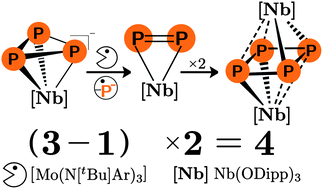Synthesis of a diniobium tetraphosphorus complex by a 2(3−1) process†
Abstract
Dimer [P2Nb(ODipp)3]2 (Dipp = 2,6-iPr2C6H3) has been obtained via a novel “2(3−1)” synthetic strategy. The mononuclear diphosphorus complex P2Nb(ODipp)3 targeted for generation by formal P− abstraction from previously reported [Na(THF)3][P3Nb(ODipp)3] ostensibly undergoes irreversible dimerization to form the [P2Nb(ODipp)3]2 complex, and is alternatively trapped reversibly by


 Please wait while we load your content...
Please wait while we load your content...